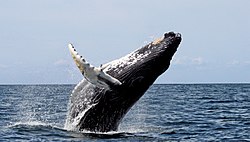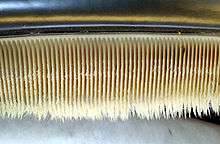Mysticeti
The Mysticeti [1] are one of the two suborders of the Cetacea.[2] They are often called baleen whales, or 'whalebone whales' or 'great whales'.
| Baleen whales Temporal range: latest Eocene - Recent
| |
|---|---|

| |
| Humpback whale breaching | |
| Scientific classification | |
| Kingdom: | |
| Class: | |
| Order: | |
| Suborder: | Mysticeti Cope, 1891
|
| Families | |
|
Balaenidae | |

Baleen whales have baleen plates made of keratin. The difference is connected with feeding. Baleen whales strain plankton out of the water, whereas the Odontoceti (toothed whales) eat larger prey.
The suborder contains four families and fourteen species.[3]
Baleen
changeBaleen whales do not have teeth, except as embryos. Fossil adult baleen whales did have teeth, but modern adults have only baleen. The embryo teeth are replaced by baleen, which look like a curtain of long plates hanging down from the top of the whale's mouth.[4] Those plates might be 12 feet long, and a foot or more wide. Looking at them from the outside, they look like straight knives hanging down, but from the inside, they are like a big toothbrush or comb. Baleen is made of keratin, a tissue also found in mammalian hair and nails.[4]
Feeding
changeA baleen whale uses its baleen to eat. In order to feed, a baleen whale opens its mouth widely and scoops in dense shoals of plankton and other small prey (such as krill, copepods, small fish and sometimes birds that happen to be near the shoals), together with a large volume of water.
The whale then partly shuts its mouth and presses its tongue against its upper jaw, forcing the water to pass out sideways through the baleen, thus sieving out the prey which it then swallows.[4]
Behavior
changeMany baleen whales make sounds. These sounds can be simple or complicated. Scientists think whales sing to communicate over long distances.[5]
Size
changeBaleen whales are generally larger than toothed whales, and females are larger than males. The group includes the largest living animal species, the blue whale.
Breaching
changeAlthough they are very heavy, baleen whales are able to jump completely out of the water. Humpback whales are known for their jumping skills, but other baleen whales also jump out from the water with their body or beat it loudly with their fins. Nobody knows for sure why the whales do this. It may be a type of communication.
Evolution
changeThe oldest true fossils of baleen are only 15 million years old, but baleen rarely fossilizes, and scientists believe it originated considerably earlier than that. Genetic evidence from DNA sequence analysis supports this idea.[6]
Baleen-related skull modifications have been found in fossils from considerably earlier. Baleen is believed to have evolved around thirty million years ago, possibly from a hard, gummy upper jaw, like the one a Dall's porpoise has. In fact, it resembles baleen closely at the microscopic level. Many early baleen whales also had teeth, but these were probably used only peripherally, or perhaps not at all (again like Dall's porpoise, which catches squid and fish by gripping them against its hard upper jaw).
Importance to humans
changeFrom the 11th to the late 20th centuries, baleen whales were hunted for their oil and baleen. Their oil can be made into margarine and cooking oils. Baleen was used to stiffen corsets, as parasol ribs, and to crease paper.
References
change- ↑ The scientific name comes from the Greek word mystidos, which means 'unknowable'.
- ↑ The other being the Odontoceti, or toothed whales.
- ↑ Mead, James G. & Brownell, Robert L. Jr. 2005. Order Cetacea (pp. 723-743). In Wilson, Don E. and Reeder, DeeAnn M. eds. Mammal species of the world: a taxonomic and geographic reference. 3rd ed, Baltimore: Johns Hopkins University Press, 2 vols. ISBN 978-0-8018-8221-0. OCLC 62265494.
- ↑ 4.0 4.1 4.2 Fudge D.S., Szewciw L.J. and A.N. Schwalb. 2009. Morphology and development of blue whale baleen: an annotated translation of Tycho Tullberg's classic 1883 paper. Aquatic mammals 35(2):226-252.
- ↑ Thomas Ling (June 22, 2021). "How humpback whales communicate through a hidden global network of song". BBC Science Focus Magazine. Retrieved July 7, 2021.
- ↑ Deméré, Thomas; et al. (2007). "Morphological and molecular evidence for a stepwise evolutionary transition from teeth to baleen in Mysticete whales". Systematic Biology. 57 (1): 15–37. doi:10.1080/10635150701884632. PMID 18266181. Retrieved 2013-12-11.